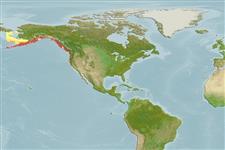>
Perciformes/Cottoidei (Sculpins) >
Agonidae (Poachers) > Hemitripterinae
Etymology: Nautichthys: Greek, nautes = sailor + Greek, ichthys = fish (Ref. 45335); oculofasciatus: Nautichthys sailor fish, in allusion to the sail-like first dorsal fin; oculofasciatus eye-banded (Ref. 4930).
More on author: Girard.
Environment: milieu / climate zone / depth range / distribution range
Écologie
marin démersal; profondeur ? - 110 m (Ref. 2850). Temperate; 66°N - 34°N
Eastern Pacific: St. Lawrence Island, Alaska to San Miguel Island, southern California, USA. Possibly occurring in Japan (Ref. 2850).
Taille / Poids / Âge
Maturity: Lm ? range ? - ? cm
Max length : 20.0 cm TL mâle / non sexé; (Ref. 2850)
Épines dorsales (Total): 8 - 9; Rayons mous dorsaux (Total): 27-30; Épines anales 0; Rayons mous anaux: 18 - 20. Caudal fin rounded, directed upward (Ref. 6885). Color variable, gray above with dark markings and obscure dusky bands, paler below; spinous dorsal darker; other fins except pelvic fins diagonally streaked darker; sometimes red flecks on rayed dorsal and on eyes; a very distinct black band running diagonally down and back through eye (Ref. 6885). A recognizable variant occurs in Knight Inlet, British Columbia - the first caudal fin is dominated by the II, III, I rather than the first four spines and the whole fin is frail and when removed from fluid appears more like a mast than a sail (Ref. 6885).
Occurs inshore and to 110 m depth, mostly on rocky bottoms and areas with algae (Ref. 2850). Nocturnal (Ref. 6885). May be found upside down against roofs of crevices (Ref. 6885). Swims with its dorsal fin extended in front of its head (Ref. 6885). Eggs deposited in late winter or spring (Ref. 6885).
Life cycle and mating behavior
Maturité | Reproduction | Frai | Œufs | Fécondité | Larves
Eschmeyer, W.N., E.S. Herald and H. Hammann, 1983. A field guide to Pacific coast fishes of North America. Boston (MA, USA): Houghton Mifflin Company. xii+336 p. (Ref. 2850)
Statut dans la liste rouge de l'IUCN (Ref. 130435)
Menace pour l'homme
Harmless
Utilisations par l'homme
Aquarium: Aquariums publics
Plus d'informations
RéférencesAquacultureProfil d'aquacultureSouchesGénétiqueElectrophoresesHéritabilitéPathologiesTraitementNutrientsMass conversion
CollaborateursImagesStamps, Coins Misc.SonsCiguateraVitesseType de nageSurface branchialeOtolithesCerveauxVision
Outils
Articles particuliers
Télécharger en XML
Sources Internet
Estimates based on models
Preferred temperature (Ref.
123201): 4.1 - 10.8, mean 7.1 °C (based on 212 cells).
Phylogenetic diversity index (Ref.
82804): PD
50 = 0.6289 [Uniqueness, from 0.5 = low to 2.0 = high].
Bayesian length-weight: a=0.00501 (0.00197 - 0.01276), b=3.15 (2.93 - 3.37), in cm total length, based on LWR estimates for this (Sub)family-body shape (Ref.
93245).
Niveau trophique (Ref.
69278): 4.1 ±0.68 se; based on food items.
Résilience (Ref.
120179): Milieu, temps minimum de doublement de population : 1,4 à 4,4 années (tm=1).
Fishing Vulnerability (Ref.
59153): Low vulnerability (10 of 100).
